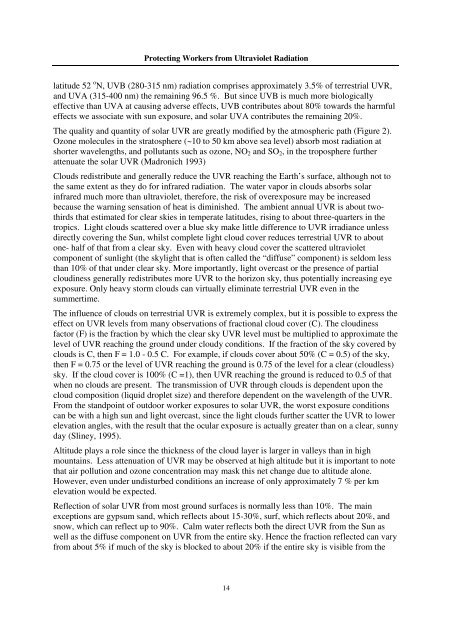Protecting Workers from Ultraviolet Radiation - icnirp
Protecting Workers from Ultraviolet Radiation - icnirp
Protecting Workers from Ultraviolet Radiation - icnirp
You also want an ePaper? Increase the reach of your titles
YUMPU automatically turns print PDFs into web optimized ePapers that Google loves.
<strong>Protecting</strong> <strong>Workers</strong> <strong>from</strong> <strong>Ultraviolet</strong> <strong>Radiation</strong><br />
latitude 52 o N, UVB (280-315 nm) radiation comprises approximately 3.5% of terrestrial UVR,<br />
and UVA (315-400 nm) the remaining 96.5 %. But since UVB is much more biologically<br />
effective than UVA at causing adverse effects, UVB contributes about 80% towards the harmful<br />
effects we associate with sun exposure, and solar UVA contributes the remaining 20%.<br />
The quality and quantity of solar UVR are greatly modified by the atmospheric path (Figure 2).<br />
Ozone molecules in the stratosphere (~10 to 50 km above sea level) absorb most radiation at<br />
shorter wavelengths, and pollutants such as ozone, NO2 and SO2, in the troposphere further<br />
attenuate the solar UVR (Madronich 1993)<br />
Clouds redistribute and generally reduce the UVR reaching the Earth’s surface, although not to<br />
the same extent as they do for infrared radiation. The water vapor in clouds absorbs solar<br />
infrared much more than ultraviolet, therefore, the risk of overexposure may be increased<br />
because the warning sensation of heat is diminished. The ambient annual UVR is about twothirds<br />
that estimated for clear skies in temperate latitudes, rising to about three-quarters in the<br />
tropics. Light clouds scattered over a blue sky make little difference to UVR irradiance unless<br />
directly covering the Sun, whilst complete light cloud cover reduces terrestrial UVR to about<br />
one- half of that <strong>from</strong> a clear sky. Even with heavy cloud cover the scattered ultraviolet<br />
component of sunlight (the skylight that is often called the “diffuse” component) is seldom less<br />
than 10% of that under clear sky. More importantly, light overcast or the presence of partial<br />
cloudiness generally redistributes more UVR to the horizon sky, thus potentially increasing eye<br />
exposure. Only heavy storm clouds can virtually eliminate terrestrial UVR even in the<br />
summertime.<br />
The influence of clouds on terrestrial UVR is extremely complex, but it is possible to express the<br />
effect on UVR levels <strong>from</strong> many observations of fractional cloud cover (C). The cloudiness<br />
factor (F) is the fraction by which the clear sky UVR level must be multiplied to approximate the<br />
level of UVR reaching the ground under cloudy conditions. If the fraction of the sky covered by<br />
clouds is C, then F = 1.0 - 0.5 C. For example, if clouds cover about 50% (C = 0.5) of the sky,<br />
then F = 0.75 or the level of UVR reaching the ground is 0.75 of the level for a clear (cloudless)<br />
sky. If the cloud cover is 100% (C =1), then UVR reaching the ground is reduced to 0.5 of that<br />
when no clouds are present. The transmission of UVR through clouds is dependent upon the<br />
cloud composition (liquid droplet size) and therefore dependent on the wavelength of the UVR.<br />
From the standpoint of outdoor worker exposures to solar UVR, the worst exposure conditions<br />
can be with a high sun and light overcast, since the light clouds further scatter the UVR to lower<br />
elevation angles, with the result that the ocular exposure is actually greater than on a clear, sunny<br />
day (Sliney, 1995).<br />
Altitude plays a role since the thickness of the cloud layer is larger in valleys than in high<br />
mountains. Less attenuation of UVR may be observed at high altitude but it is important to note<br />
that air pollution and ozone concentration may mask this net change due to altitude alone.<br />
However, even under undisturbed conditions an increase of only approximately 7 % per km<br />
elevation would be expected.<br />
Reflection of solar UVR <strong>from</strong> most ground surfaces is normally less than 10%. The main<br />
exceptions are gypsum sand, which reflects about 15-30%, surf, which reflects about 20%, and<br />
snow, which can reflect up to 90%. Calm water reflects both the direct UVR <strong>from</strong> the Sun as<br />
well as the diffuse component on UVR <strong>from</strong> the entire sky. Hence the fraction reflected can vary<br />
<strong>from</strong> about 5% if much of the sky is blocked to about 20% if the entire sky is visible <strong>from</strong> the<br />
14



